
 |
Having spent considerable time exploring Tablet Computers (call them slates, whatever) and being skeptical from the outset that the idea of a write-on screen was nothing but a bit naff, I settled in to some long term trials and this document examines a couple of machines that I think are worthy of note. One of which I have purchased and use all the time, the other I want to purchase but seem unable to do so for now due to shipping/production delays.
It should be noted that opinions expressed here are my own and may not correspond to official school position (if they actually have one). They are based on personal experience and facts which i hope I have gotten right (please do not sue me, I am only a teacher and cannot afford a court case).
 We purchased a Fujitsu Stylistic, a docking station (with DVD/CDRW combo drive), 6 hour duration battery as opposed to the standard 4 hour one that comes standard. It came standard with a plastic stand, IR keyboard (battery powered), stylus and an 80Gb HDD and nice padded carry purse. I also bought a leather portfolio case and regret that purchase as it doesn't quite fit, the holes for buttons and ports do not quite line up but it does look nice and impresses those who will only ever be interested in outward appearances. It runs 802.1b+g wireless via a built-in adapter, supports WEP and WPA wireless security and has a punchy centrino processor.
We purchased a Fujitsu Stylistic, a docking station (with DVD/CDRW combo drive), 6 hour duration battery as opposed to the standard 4 hour one that comes standard. It came standard with a plastic stand, IR keyboard (battery powered), stylus and an 80Gb HDD and nice padded carry purse. I also bought a leather portfolio case and regret that purchase as it doesn't quite fit, the holes for buttons and ports do not quite line up but it does look nice and impresses those who will only ever be interested in outward appearances. It runs 802.1b+g wireless via a built-in adapter, supports WEP and WPA wireless security and has a punchy centrino processor.
It runs XP tablet edition, and has a number of tablet-specific apps with that (Windows Journal being the most used to date). Because there was room on the HDD, I also added Office, Delphi, The Corel Suite (including Bryce), the Macromedia Suite, some music making software and iTunes (this is a real MP3 player :). Most of this software was not really needed due to our school infrastructure, but there was room on the HDD and I felt duty bound to use it. Citrix program neighborhood is used to connect into our school's thin-client infrastructure and to the vast array of software tools available but I decided that some stand-alone capability would increase the utility of the machine in those dead spots on the planet where wireless was not available.
This machine is used daily - I use it instead of an OHP in my classroom, tied to a data projector and connecting wirelessly to the school network, this is IWHO the ultimate feature-rich platform to teach with. I use journal to create "blackboard summaries" hand-written, with colours (journal has coloured pens and highlighters), rip them as PDFs and post them on the net for my students (often there and then during the lesson). This mode of operation suits the way I want to use an in-class display device well. The display is bright, easy to read and flexible enough to be _really_ useful. I could also use powerpoint and covert to blackboard mode, use digital chalk and so on - this seems a little naff to me but amusing as it emulates tried and true blackboard display - what next, the kids will be writing on slates .... what an interesting idea!!!
The Fuji gets "borrowed" whenever I am not using it (and this is fine, it is robust and so long as it is powered up when I want it, then there is no problem... unless someone loses the stylus on me. Interestingly, I tied my stylus to the tablet via a lanyard and it got misplaced on the first borrow - thankfully it turned up it but highlighted how difficult to use a tablet pc is without a stylus). Actually getting it to project turned out to be an adventure in discovering the hidden feature below 5 menus of choices (right-click on the desktop -> properties -> settings -> advanced -> display tab -> advanced -> enable dual screen display -> ok -> ok -> ok -> ok, and rest). A quicker way thru would be lovely (like an entry on the Fuji tabletmenu perhaps?) but it is workable (although hilariously bad user interface design).
XP tablet has a lot of great pen-supporting features, and if the pen-to-cursor registration is good (on the fuji it is great), then handwriting recognition is excellent. I do not like it when it then spell-checks my handwriting as the results (in coding applications for example) are hilarious initially, tedious once you get over that. Some applications accept hand-writing directly into them (via a little floating window), others will only accept keyboard or onscreen tap-keyboarding - this seems application specific and difficult to predict. All too often you have lots to enter and a keyboard (either the IR one or a USB one I also use from time to time) is the most logical input device - tap-keying is tedious for anything other than username/password type things, and to correct the occasional oddly converted word. The stylus has an annoying raised button that is intended to be programmed (like for a right click) but I find it gets in the way and when you accidentally depress it while writing, your writing is mashed badly - all attempts to disable the button completely have so far been unsuccessful but I am still searching feature menus.
The Fuji seems to suffer (there are a couple of them in our school now, all similarly inflicted) with allergy to smart mouses - my USB optical mouse causes the cursor into apoplectic click-frenzies but a dumber-ball laden mouse works fine. The IR keyboard works well but needs to be carefully aligned with the IR port, and when it's batteries are flat it becomes hilariously inaccurate in it's typing. The Fuji wireless drivers that shipped with the tablet seemed a little flaky, but when replaced with others it now works flawlessly on home and school network, picks up 3 networks on the bus on the way home and is generally agreeable in it's encounters with other wifi hotspots. This machine is light (the battery weighs it down the most) and portable and definitely not a toy.
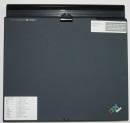 I was told IBM are about to enter the tablet computer market and am still being told this. After discussions about how that might happen, and shifting horizons on when, we were finally sent an engineering sample of an IBM tablet computer based on the IBM "X" series laptop - badged the IBM X41.
I was told IBM are about to enter the tablet computer market and am still being told this. After discussions about how that might happen, and shifting horizons on when, we were finally sent an engineering sample of an IBM tablet computer based on the IBM "X" series laptop - badged the IBM X41.
Unfortunately (note: to get a REAL feel for a machine, I need to use it for my day to day business for a couple of days - due to the delivery deadline and the imperative to ship it to Singapore ASAP that was not possible) I only had my hands on this machine for a couple of days (well, much less than that really as it was handed around to all who were interested at our school - lots of teachers and admin staff and mothers group and all as it turns out). Observations are based on the machine presented and my not be reflective of the actual production model, should that emerge.
The IBM "X" series laptop is one of the most impressive machines I have seen to date on a number of fronts. It weights very little (compared to any laptop I have seen, and most of the tablets/slates I have trialled) has a small footprint (slightly smaller that an A4 page) and has a coated Magnesium case making it fairly rugged to begin with, coupled with a punchy processor and HDD immobilisation software this is one nuggety machine (maybe tough enough to survive school kids?). The one we were sent had a new style battery with a stated 10 hour duration - this is seriously useable in a school. It has a full-sized keyboard and there were 2 (or 3ish, one was a different shape and as we received no documentation, I do not know what it was for) USB ports, an SD card slot, PCMCIA bay, full sound card, gamer-friendly display adapter, 80Gb HDD, "nipple" mouse and ran cool (well, yes, it looked cool also, but temperature-wise it ran cool, not scalding me or the furniture when left working for some time). The X41 shipped with a TABLET screen (ie. it was ruggedised, and you could write on it) that pivoted 180 degrees and locked down over the keyboard. The screen had a number of commonly used buttons (enter, escape) along with swizzle (change display orientation), power, scrollers and so on so the computer could be driven without resorting to the keyboard. It comes standard with integrated WiFi a,b and g (as you would expect), the reception is brill and it roams seamlessly between access points, has an ethernet jack and a modem jack, full sound card but NO CD/FDD. I was told that these could be supplied in a docking station but I have not seen such an animal for this device so cannot comment on it.
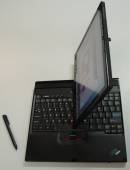 My concerns for machines with moving parts is that they can break. My concerns for machines with moving parts used in schools is that kids break them - sometimes maliciously, other times by accident. I am realistic enough (and sadly I have seen that sort of damage often enough) to look at the 'ideal world' through a pair of "spot the liability" glasses. The pivot point on the X41 (like ALL the pivot pointed tablets I have seen) represent a significant point of design weakness. Carefully, I rotated the screen 90 degrees in the direction hinted at by an indicator arrow then gently I
My concerns for machines with moving parts is that they can break. My concerns for machines with moving parts used in schools is that kids break them - sometimes maliciously, other times by accident. I am realistic enough (and sadly I have seen that sort of damage often enough) to look at the 'ideal world' through a pair of "spot the liability" glasses. The pivot point on the X41 (like ALL the pivot pointed tablets I have seen) represent a significant point of design weakness. Carefully, I rotated the screen 90 degrees in the direction hinted at by an indicator arrow then gently I  held the base of the machine whilst pushing the screen (not that a kid would do this, no, not much) and noted the initial flexion in the joint (yes, it is fairly tough) but had I continued there would have been an ugly snapping sound as the top separated from the body.
held the base of the machine whilst pushing the screen (not that a kid would do this, no, not much) and noted the initial flexion in the joint (yes, it is fairly tough) but had I continued there would have been an ugly snapping sound as the top separated from the body.
There is a very real possibility the user of this screen could legitimately get confused (I know I did when first trying to work out how to close the thing) and rip the screen off accidentally (or at least do damage at the pivot point) as the case is MARKED with a pivot direction ARROW - this arrow correctly identifies the direction you pivot to open up the device however when closing it up it is an ERROR to follow the only visible marker (that same arrow). This is disappointing as, by design this could be easily obviated by having a close arrow printed on the surface visible outside the machine, to serve as a guide on how to safely close the lid. Alternatively, I wonder how much more it would cost to manufacture a pivot point that could go the full 360 degrees, not caring what direction the screen was swizzled - thus obviating the need to mark the case or concern the user (or am I alone in this thought?).
 As the screen is also the laptop (tablet top?) lid, when it is pivoted to be tablet-side up, it needs to be locked in place else it rattles annoyingly on the keyboard underneath when you write on it. To achieve this, there is a plastic catch that extends right through the lid, and can be pushed through from side to side depending on where it needs to latch. It is plastic and might benefit from being not so because if it breaks, the lid can not be closed or secured. Black anodized aluminum or something might make it less flimsy and may also make the latching action feel a little more secure.
As the screen is also the laptop (tablet top?) lid, when it is pivoted to be tablet-side up, it needs to be locked in place else it rattles annoyingly on the keyboard underneath when you write on it. To achieve this, there is a plastic catch that extends right through the lid, and can be pushed through from side to side depending on where it needs to latch. It is plastic and might benefit from being not so because if it breaks, the lid can not be closed or secured. Black anodized aluminum or something might make it less flimsy and may also make the latching action feel a little more secure.
 The X41 shipped with a Thumb-print reader as a form of biometric authentication device. The idea is cute but in a school you might not want to muck around with registering all the thumb-prints of all kids. Interestingly, either the one we were sent was faulty, or the technology is not yet ripe as after registering and confirming my right thumb print, it then would not let me in via that thumb again - although it let me in when I used my pinky (little finger - left hand only, curiously), and amusingly my right elbow. Power management on the machine (default settings) were so aggressive that it went into standby mode after 5 minutes of inactivity and you cannot tap on ctrl-alt-delete as the OS tells you to use a "security" button instead (which does not exist on the tablet top) - I had to access the keyboard to get back into the machine again which was a little annoying. Power management can be easily customized though so I would have gotten around that I imagine if I was working with the machine for longer.
The X41 shipped with a Thumb-print reader as a form of biometric authentication device. The idea is cute but in a school you might not want to muck around with registering all the thumb-prints of all kids. Interestingly, either the one we were sent was faulty, or the technology is not yet ripe as after registering and confirming my right thumb print, it then would not let me in via that thumb again - although it let me in when I used my pinky (little finger - left hand only, curiously), and amusingly my right elbow. Power management on the machine (default settings) were so aggressive that it went into standby mode after 5 minutes of inactivity and you cannot tap on ctrl-alt-delete as the OS tells you to use a "security" button instead (which does not exist on the tablet top) - I had to access the keyboard to get back into the machine again which was a little annoying. Power management can be easily customized though so I would have gotten around that I imagine if I was working with the machine for longer.
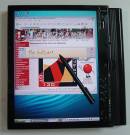 The stylus for this machine feels and looks like a comfortable biro - has good hand feel and the screen to stylus registration was excellent (once calibrated). It had a nicely recessed programmable button that does not get in the way of holding the stylus. A nice touch would be some rubberized grip near the tip (or maybe that is an idea for an optional, luxury add-on). It's hand writing recognition was excellent (it can read my writing, which is no mean feat as I can not sometimes). The stylus tucks away nicely into the base of the machine in a spring-loaded bay although there is no way to tether it to the machine - just a bit wary of it going missing - one hopes you can purchase them separately in case it goes walkabout. I was disappointed that the flat end (as opposed to the pointy end) did not act as an ERASER (as is the case on some other machines of a similar ilk) and would be neato if it did. The buttons on the top of the tablet lid were big enough to be poked at with chunky fingers like mine, recessed so your didn't accidentally activate them while resting the heel of your palm on the screen and as a nice design touch has slightly recessed pits in them so you could activate them with your stylus and not have the stylus skid off in an un-controlled way.
The stylus for this machine feels and looks like a comfortable biro - has good hand feel and the screen to stylus registration was excellent (once calibrated). It had a nicely recessed programmable button that does not get in the way of holding the stylus. A nice touch would be some rubberized grip near the tip (or maybe that is an idea for an optional, luxury add-on). It's hand writing recognition was excellent (it can read my writing, which is no mean feat as I can not sometimes). The stylus tucks away nicely into the base of the machine in a spring-loaded bay although there is no way to tether it to the machine - just a bit wary of it going missing - one hopes you can purchase them separately in case it goes walkabout. I was disappointed that the flat end (as opposed to the pointy end) did not act as an ERASER (as is the case on some other machines of a similar ilk) and would be neato if it did. The buttons on the top of the tablet lid were big enough to be poked at with chunky fingers like mine, recessed so your didn't accidentally activate them while resting the heel of your palm on the screen and as a nice design touch has slightly recessed pits in them so you could activate them with your stylus and not have the stylus skid off in an un-controlled way.
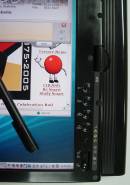
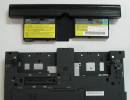 The battery was fairly light by comparison to others I have seen and protrudes nicely to give you something comfortable to grab while holding and using it. The power management seemed unable to tell me how long the battery had left - the juice meter dropped from 99% down to 57% in an hour (telling me I had 1.48 hours of battery life remaining) and continued to tell me much the same for the next 4 hours - I think that might be a windows thing, one never knows. I happily used it for ages and there is something liberating about having a battery with such a long life - you do not spend much time searching the current room you are in for an adjacent power outlet just in case or worrying whether you have packed the power adapter. The tablet lid had a power button on it and you could LOCK the power on/off via a plastic slide thingy - what a nice touch. This longevity of power is a boon for schools plagued with battery life of 2-4 hours and when coupled with thin-client processing will further enhance capabilities (as I/O gets handled by the server farm, HDDs on the local machine barely tick over).
The battery was fairly light by comparison to others I have seen and protrudes nicely to give you something comfortable to grab while holding and using it. The power management seemed unable to tell me how long the battery had left - the juice meter dropped from 99% down to 57% in an hour (telling me I had 1.48 hours of battery life remaining) and continued to tell me much the same for the next 4 hours - I think that might be a windows thing, one never knows. I happily used it for ages and there is something liberating about having a battery with such a long life - you do not spend much time searching the current room you are in for an adjacent power outlet just in case or worrying whether you have packed the power adapter. The tablet lid had a power button on it and you could LOCK the power on/off via a plastic slide thingy - what a nice touch. This longevity of power is a boon for schools plagued with battery life of 2-4 hours and when coupled with thin-client processing will further enhance capabilities (as I/O gets handled by the server farm, HDDs on the local machine barely tick over).
A major oversight on the part of the manufacturer was the mis-badging - this machine should be labeled the X42, surely (it seems part of the answer to "life, the universe and everything" or should that be "schools, learning and everything")? One only hopes the pricing on this little beauty is attractive as it offers real potential in a school environment. Portables are one part of the computer access solution in schools (or should be) and when the portable has tablet capabilities as well as "conventional" laptop capabilities, it makes them killer devices for learning, with the users MUCH LESS likely to resist them as just another educational space-invader.
Let us hope there will be something like this that normal human beings (well, ok, school technology people) can purchase in a cost-effective way in the not to distant future, lord knows it has been well overdue.
Join an active online teaching community and share your opinions/concerns ...
Mail me with your ideas/feedback - I'll post it for others to see if you like.